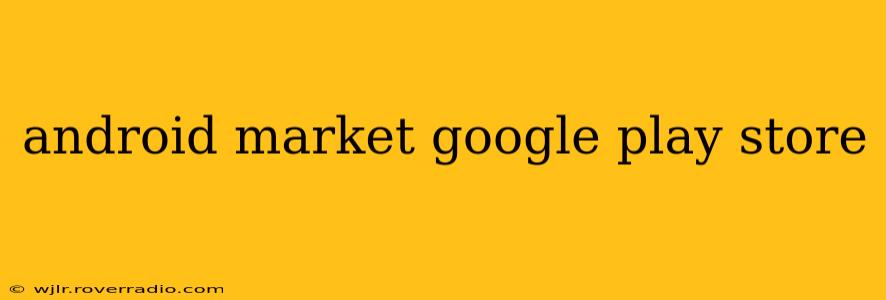The terms "Android Market" and "Google Play Store" are often used interchangeably, but they aren't quite the same. Understanding their relationship is crucial for anyone navigating the world of Android apps. This comprehensive guide will explore their history, differences, and the current state of the Android app ecosystem.
What was the Android Market?
The Android Market was the original app store for Android devices. Launched in 2008, it served as the central hub for discovering and downloading applications for early Android smartphones and tablets. It was a relatively simple platform compared to its successor, lacking many of the features and refinements we see today. Think of it as the pioneering stage of Android's app distribution. Its limitations paved the way for the improved Google Play Store.
The Evolution to Google Play Store: A Quantum Leap
In 2012, Google significantly revamped its Android app store, rebranding it as the Google Play Store. This wasn't just a name change; it marked a major upgrade in functionality, design, and content. The rebranding signaled a broader vision for Google's digital content ecosystem, encompassing more than just apps.
The Google Play Store now includes:
- Apps: A vast library of Android applications covering every imaginable category.
- Games: A dedicated section for mobile games, often featuring top charts and curated collections.
- Movies & TV: Streaming and purchase options for films and TV shows.
- Books: E-books, audiobooks, and more.
- Music: Streaming services and digital music purchases.
- Magazines & Newspapers: Subscriptions and individual purchases of digital publications.
This expansion beyond just apps made Google Play a comprehensive digital marketplace, significantly enhancing user experience and broadening its appeal.
Key Differences Between Android Market and Google Play Store
The primary difference is the scope and functionality. The Android Market was primarily focused on apps, while the Google Play Store is a multifaceted digital content hub. Other key distinctions include:
- User Interface: The Google Play Store boasts a more polished and intuitive user interface, making navigation and app discovery significantly easier.
- Features: The Google Play Store offers advanced features such as parental controls, in-app purchases, subscription management, and detailed app information.
- Security: Google has implemented robust security measures in the Google Play Store, including rigorous app vetting processes to minimize the risk of malicious software.
- Content Variety: The Android Market only offered apps. The Google Play Store expanded to include movies, books, music, and more.
What Happened to the Android Market?
The Android Market ceased to exist once the Google Play Store launched. It was entirely superseded by the upgraded platform, and any apps previously available on the Android Market became available on the Google Play Store.
Is Google Play Store the Only Way to Install Android Apps?
While the Google Play Store is the official and recommended method, it's not the only way. Users can sideload apps from other sources, though this practice carries security risks if not done cautiously. Always download apps from trusted sources to minimize the chances of installing malware.
How Does Google Play Store Make Money?
Google Play Store generates revenue through various means:
- Developer Fees: Developers pay a commission to Google for each app sale or in-app purchase.
- Advertising: The Play Store incorporates advertising, which generates revenue for Google.
- Subscription Services: Google earns revenue from subscription services offered through the Play Store, such as music and magazine subscriptions.
What are the Alternatives to Google Play Store?
While the Google Play Store dominates the Android app market, alternative app stores exist. These include Amazon Appstore, Samsung Galaxy Store, and others. However, these often have a smaller selection of apps compared to the Google Play Store.
This in-depth analysis highlights the evolution from the simpler Android Market to the sophisticated Google Play Store. Understanding this evolution provides context to the current landscape of Android app distribution and the dominant role Google Play Store plays in the Android ecosystem.
